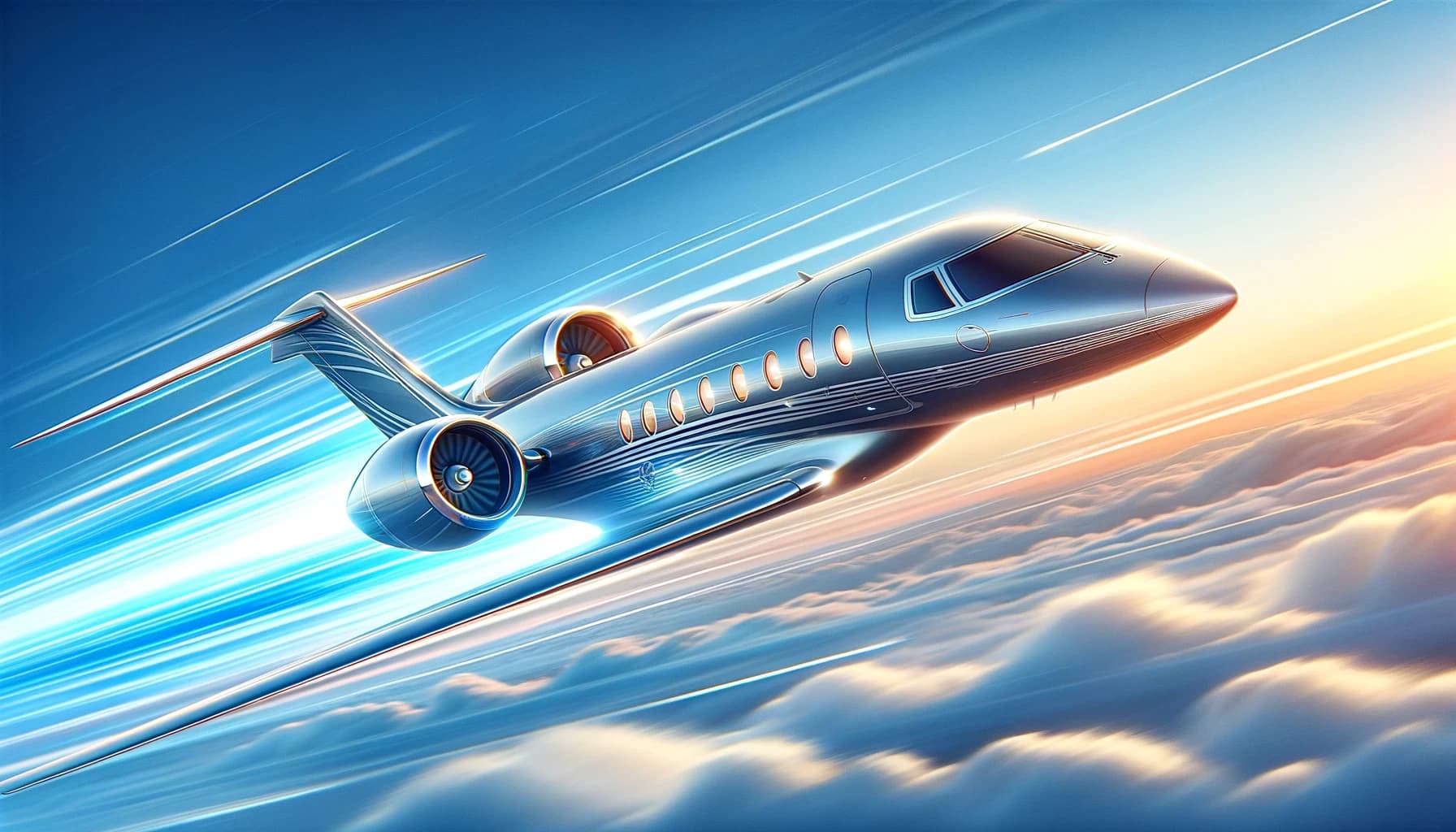
Have you visited an airshow, you must know about the aircraft’s speediness and what are the world’s fastest private jet. You must be wondering how these jets can fly with extremes of speed and are the fastest traveling route in the current era. Private jets are excelling in terms of speed and beating commercial flights. Interested in feeling the thrill of flying in a high-speed private jet? Don’t just read about it – experience it for yourself! Request an instant quoteon your next flight.
Commercial jets typically cruise at speeds between 500 to 600 miles per hour (800 to 970 kilometers per hour). However, the speed can vary depending on the type of aircraft and flight conditions. Military jets are faster, with some capable of supersonic speeds exceeding 1,000 mph (1,609 kph). The exact speed of a jet depends on its design, purpose, and current flight conditions.
Let’s dig into the details of some of the types of fastest private jets.
- NASA/ USAF X- 15
This aircraft is the Fastest operated Air bird produced, with a top speed of Mach 6.72 or 4,500 miles/hour is the fastest private jet speed. The purpose of the creation of this aircraft is to reach outer space. However, a bigger fish in the sea has a record of top speed higher than the NASA/USAF X – 15. The fastest fighter plane serving the military right now is MiG -25 Foxbat.
- MiG – 25 Foxbat
This military jet is competent to reach the speed of Mach 3.2 or 2190 miles/hour. This aircraft is the only aircraft that can operate at a rate above Mach 3.0. It is a supersonic interceptor aircraft that the Soviet Union designed. MiG -25 Foxbat was created using only stainless steel.
TOP SPEEDS OF FAST PRIVATE JETS
The fastest private jets reach impressive speeds, rivaling commercial jets. Among them, the Cessna Citation X+ tops the list, followed by the Bombardier Global 6000 and Gulfstream G650ER.
- Cessna Citation X and Citation X+
Cessna Citation X and Citation X+ are super-fast long-range medium business jets. Both jets overshadow other jets in line with their outstanding features and specs. The citation X+ possesses the speed of Mach 0.935 (536 kt, 993 km/h). This remarkable feature makes it the fastest civil aircraft in the mighty blue sky. It has a cruising speed of up to 51,000ft. Citation X is the base model with a full steam of 528kt or 978 km/h. Both aircraft are fuel-saving, and fuel-efficient, and can carry up to 9 passengers on board. They keep the cargo safe in a heated pressurized baggage chamber.
- Gulfstream G- 500
This mighty bird can stretch its wings up to a top speed of 516kt, 956 km/h, along with a range of 9816 km. This aircraft fulfills all the standards of luxuries providing the passenger with swift, smooth, and pleasant intercontinental flights. The design of this long-range aircraft is based on the famous Gulfstream IV.
- Bombardier Global 6000
This jetliner is classified as an ultra-long-range business plan with a maximum speed of 513kt, 950 km/h, and a vast range of 5960 nautical miles. Bombardier Global 6000 can accommodate up to 16 passengers offering the option of private staterooms. It has a spacious baggage compartment, Wi-Fi, and comfortable seating. It can be an ideal carrier for a long voyage.
- Gulfstream G650
The feature that makes this one of the best private jet is its supercilious environmental control that blesses the cabin with fresh air within two minutes. This property of Gulfstream G650 endows the passenger with tireless air travel and a homely atmosphere. Gulfstream G650 has recently set the record for the world’s fastest private jet by traveling from Sydney to Los Angeles. The jet covered 6,620 nautical miles within 12 hours and 40 minutes at an average flying speed of 0.86 Mach.
- Dassault Falcon 7X
This liner is imagined as the perfect ‘Office in the blue yonder’ because of its world-class luxuries, noise-damping build, and business resources. This jet has a flying speed of 515 kt or 954 km/hour and 5950 nautical miles. It can carry up to 15 passengers. It is famous for its mighty interior. There are a variety of factors that determine the speed of an airplane. Let’s determine why private jets are faster and what impacts their rate.
PRIVATE VS. COMMERCIAL JET SPEEDS
While commercial jets cruise at around 500-600 mph, many private jets offer comparable speeds. For instance, the Cessna Citation X+ can reach up to 717 mph, closely approaching commercial aircraft capabilities.
Weather
Weather can significantly influence private jet speed. Airplanes tend to slow down in terrible weather. In contrast, whether aircraft can cover the same distance in a shorter duration is clear.
Headwinds
Headwinds impact the aircraft’s speed at every point, such as at takeoff, during flight, and then during the landing phase. During the launch and landing phases, headwinds introduce a more excellent airflow that assists in the early lift. That’s why private jets are speedy, require smaller runways, and can land at smaller airports.
Flight Altitude
Lower-flying jets are exposed to higher air pressure, so they fly at a relatively lower speed. Private jets, lighter than commercial flights, can fly at higher altitudes with incredible speed.
Streamlined Shape
Private jets are more streamlined in shape than giant commercial airplanes. The more streamlined an aircraft is, the less turbulence it faces. The higher speed of the private jet is due to its sleek, streamlined shapes, which are exposed to lower turbulence.
Aircraft’s Speed Measuring Units
As we all know, when a jet is moving in the air, the ground is also moving below it. So, aircraft speed is not a single entity, but we take it as three divisions: calibrated airspeed indicated airspeed and true airspeed. When we talk about the aircraft’s speed, we generally consider true airspeed (TAS). While the unit of true airspeed is “KNOTS,” and it can also be represented as KTAS.
Plane’s Speed in MPH
A knot equals one nautical mile per hour. That is approximately 1.852 km/h, or 1.1508 miles per hour.
FACTORS AFFECTING PRIVATE JET SPEED
The speed of private jets is influenced by their design, engine power, and aerodynamics. Advanced technology and materials allow for higher speeds and efficiency, making them competitive with commercial planes in terms of velocity.
Wondering About Mach Number, here it is!
If you’re curious what the Mach number is, it’s derived by dividing an aircraft’s speed by the speed of sound. Speeds less than Mach 1 are referred to as subsonic, whereas rates more than Mach 1 are referred to as supersonic. You’re considered transonic if moving at Mach 1. And if you’re flying at hypersonic speeds (more than Mach 5), you’ll know you’re on a test aircraft (or an extraterrestrial spaceship!).
Let’s know about Commercial Aircraft Speed.
Large commercial jets fly from 550 to 580 miles per hour, but their landing and take-off speeds vary. Most commercial jets fly from 160 to 180 miles per hour, with landing speeds ranging from 150 to 165 miles per hour.


